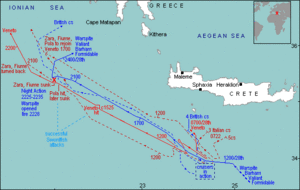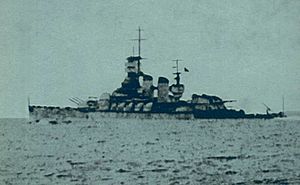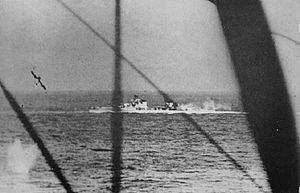Battle of Cape Matapan facts for kids
The Battle of Cape Matapan was a major naval battle during World War II. It happened between the Allied navies (mainly from the United Kingdom and Australia) and the Italian Royal Navy. The battle took place from March 27 to 29, 1941, near Cape Matapan on the coast of Greece.
During this battle, Allied ships, led by British Admiral Sir Andrew Cunningham, attacked and sank or badly damaged several ships of the Italian Regia Marina. The Allies had a secret advantage: they could read Italian naval codes thanks to a team at Bletchley Park in England. This secret information was called Ultra. The first part of this battle is also known as the Battle of Gaudo in Italy.
Quick facts for kids Battle of Cape Matapan |
|||||||
|---|---|---|---|---|---|---|---|
| Part of the Battle of the Mediterranean | |||||||
 Map of the battle |
|||||||
|
|||||||
| Belligerents | |||||||
| Commanders and leaders | |||||||
| Strength | |||||||
| 1 aircraft carrier 3 battleships 7 light cruisers 17 destroyers |
1 battleship 6 heavy cruisers 2 light cruisers 13 destroyers |
||||||
| Casualties and losses | |||||||
| 3 killed 4 light cruisers damaged 1 aircraft destroyed |
2,300 killed 1,015 captured 3 heavy cruisers sunk 2 destroyers sunk 1 battleship damaged 1 destroyer damaged |
||||||
Contents
Why Did the Battle Happen?
In March 1941, British ships were helping to move troops to Greece. At the same time, a codebreaker named Mavis Batey at Bletchley Park made a big discovery. She managed to read the Italian naval codes for the first time.
The secret messages revealed that an Italian battle fleet was sailing to attack British supply ships. This fleet included a battleship, several heavy and light cruisers, and destroyers.
To keep their secret code-breaking hidden, the British made it look like they found the Italian fleet by chance. They used a reconnaissance plane to "spot" the Italian ships.
Admiral Cunningham, the British commander, also pretended to be staying at a golf club in Alexandria. He wanted to make sure no one saw him secretly boarding his flagship, the battleship HMS Warspite. This made the enemy think he was not at sea.
Meanwhile, the Axis side (Italy and Germany) had wrong information. The Germans told the Italians that the British fleet had only one battleship and no aircraft carriers. But the British actually had three battleships and a new aircraft carrier, HMS Formidable.
Who Fought in the Battle?
The Allied Forces
The Allied force was the British Mediterranean Fleet. It included:
- The aircraft carrier HMS Formidable
- Three powerful battleships: Barham, Valiant, and Warspite
- Seven light cruisers: HMS Ajax, Gloucester, Orion, and the Australian light cruiser HMAS Perth, plus Carlisle, Calcutta, and Bonaventure
- Seventeen destroyers, including HMS Jervis, Janus, Mohawk, Nubian, HMS Greyhound, Griffin, HMAS Stuart, HMS Hotspur, Havock, HMS Hasty, Hereward, Ilex, HMS Defender, Jaguar, Juno, HMS Decoy, and HMAS Vampire.
The Italian Forces
The Italian fleet was led by Admiral Angelo Iachino. It included:
- One modern battleship: Vittorio Veneto
- Six heavy cruisers: Zara, Fiume, Pola, Trieste, Trento, and Bolzano
- Two light cruisers: Luigi di Savoia Duca degli Abruzzi and Giuseppe Garibaldi
- Thirteen destroyers, including Alpino, Bersagliere, Fuciliere, Granatiere, Alfredo Oriani, Giosuè Carducci, Vincenzo Gioberti, Vittorio Alfieri, Ascari, Corazziere, Carabiniere, Emanuele Pessagno, and Nicoloso da Recco.
A key difference was that none of the Italian ships had radar, while several Allied ships did. Radar allowed the British to "see" ships in the dark or through fog.
The Battle Begins
On March 27, 1941, Admiral Cunningham's main fleet left Alexandria, Egypt. At the same time, a group of Allied cruisers under Vice-Admiral Henry Pridham-Wippell sailed from Greece.
An Allied Sunderland flying boat spotted the Italian fleet at noon, taking away their element of surprise. The Italian admiral, Iachino, also learned that the British aircraft carrier HMS Formidable was at sea. Despite this, the Italians decided to continue their mission. They wanted to show the Germans they were ready to fight.
Action Near Gavdos Island
On March 28, an Italian plane spotted the British cruiser squadron. The Italian cruisers chased the British ships, opening fire from a long distance. They fired many shells but didn't hit anything important. The British cruisers fired back, causing the Italians to change course.
After an hour, the Italian cruisers gave up the chase and turned to rejoin their battleship, Vittorio Veneto. The Allied ships followed them from a distance. Admiral Iachino hoped to lure the British closer to his battleship.
At 10:55 AM, Vittorio Veneto joined the Italian cruisers and immediately started firing at the Allied cruisers. The British cruisers, surprised to see a battleship, quickly pulled back. They received only minor damage from shell fragments.
Air Attacks on Italian Ships
Admiral Cunningham's force launched an attack with Fairey Albacore torpedo bombers from HMS Formidable. They attacked Vittorio Veneto, forcing the Italian ships to move around, which made it hard for them to continue chasing the British. The Italian ships fired back, defending themselves.
A second air attack at 3:09 PM surprised the Italians. A torpedo bomber managed to get very close to Vittorio Veneto and launched a torpedo. It hit the battleship's outer left propeller, causing a lot of water to flood in. The plane and its crew were shot down. The battleship stopped for repairs but was able to move again at 16:42, though at a slower speed. When Cunningham heard about the damage, he began to chase the Italian fleet.
A third air attack happened between 7:36 PM and 7:50 PM. Admiral Iachino tried to protect Vittorio Veneto using smoke and searchlights. This prevented further damage to the battleship. However, one torpedo hit the Italian heavy cruiser Pola. Pola had almost stopped to avoid hitting another ship and couldn't move out of the way. This hit knocked out its power, leaving it dead in the water.
The Italian admiral, unaware that Cunningham was chasing him, ordered a squadron of cruisers and destroyers to go back and help Pola. This squadron included Pola's sister ships, Zara and Fiume.
Night Action: A Surprise Attack
At 8:15 PM, a British cruiser, HMS Orion, detected Pola on its radar. The main Allied force detected the Italian squadron on radar shortly after 10:00 PM. They were able to get very close without being seen. The Italian ships had no radar and couldn't see the British ships in the dark. Also, their main guns were not ready for a night battle.
At 10:20 PM, the Italians finally spotted the Allied squadron, but they thought they were their own ships. The British battleships Barham, Valiant, and Warspite got very close, about 3,800 yards away. This was point-blank range for their powerful guns. They then opened fire.
The Allied searchlights, including one controlled by Prince Philip aboard Valiant, lit up the Italian ships. British gunners saw huge turrets flying into the air from the Italian cruisers. Fiume and Zara were destroyed in minutes. Fiume sank at 11:30 PM, and Zara was finished off by a torpedo from the destroyer HMS Jervis early on March 29.
Two Italian destroyers, Vittorio Alfieri and Giosuè Carducci, were also sunk very quickly. The other two, Gioberti and Oriani, managed to escape using a smoke screen, though Gioberti was badly damaged.
The British considered towing Pola away as a prize, but it was getting light, and they feared air attacks. Pola's crew was taken off, and the ship was sunk by torpedoes from the destroyers Jervis and Nubian after 4:00 AM.
The Allied ships rescued survivors but left the area in the morning, still worried about air strikes. Admiral Cunningham sent a message to the Italian High Command, telling them where the remaining survivors were and offering safe passage for an Italian hospital ship to pick them up. The Italian hospital ship Gradisca came and rescued more sailors.
The Allies lost only one torpedo bomber and its three-man crew. The Italians suffered heavy losses, with about 2,303 sailors killed, mostly from Zara and Fiume. The Allies rescued 1,015 survivors, and the Italians saved another 160.
What Happened After the Battle?
The Battle of Matapan was a major defeat for the Italian navy. They lost three heavy cruisers and two destroyers. This made the British navy much stronger in the Mediterranean Sea.
Even though the British won a great victory, Admiral Cunningham was a bit disappointed. He wished his destroyers had been able to catch and sink the Italian battleship Vittorio Veneto, which managed to escape.
The Italian fleet did not venture far into the Eastern Mediterranean again for a long time after this battle.
The Secret of Bletchley Park
For many years, the secret work of the codebreakers at Bletchley Park was kept hidden. But their role in the Battle of Cape Matapan was a rare exception. A few weeks after the battle, Admiral Cunningham visited Bletchley Park to thank the codebreakers, especially Mavis Batey. This greatly boosted their morale.
Admiral John Godfrey, the Director of Naval Intelligence, famously said: "Tell Dilly [[[Dilwyn Knox|Dilly Knox]], another codebreaker] that we have won a great victory in the Mediterranean and it is entirely due to his girls."
After the war, the details of the code-breaking were kept secret for decades. It wasn't until 1978 that records were finally made public. This showed how important the work at Bletchley Park was to the Allied victory.
Images for kids







